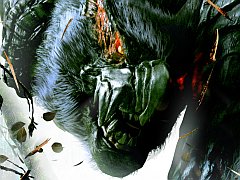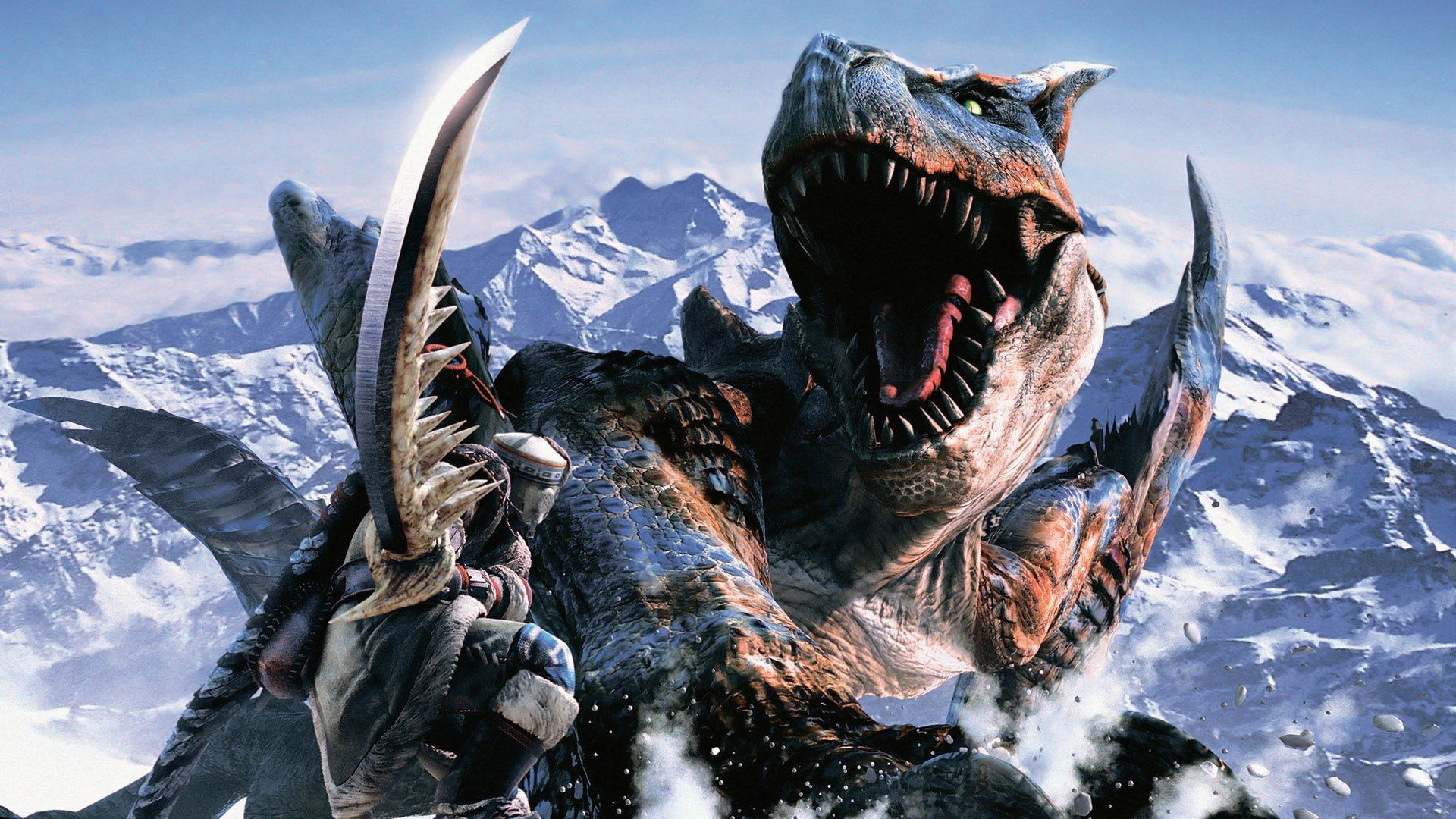You can trust VideoGamer. Our team of gaming experts spend hours testing and reviewing the latest games, to ensure you're reading the most comprehensive guide possible. Rest assured, all imagery and advice is unique and original. Check out how we test and review games here
Monster Hunter highlights perfectly the cultural divide that exists between Japanese and Western gamers. In Japan, Monster Hunter is a mainstream phenomenon in the same way that Nintendo’s Wii and DS are. The last game, Monster Hunter Portable 2G on PSP, has sold over three million units in the Land of the Rising Sun. And, like Nintendo’s Wii, its success is down to its social appeal – Japanese come together to play the game cooperatively in public. You see groups of teenage boys huddled together at Tokyo train stations, each one staring into a PSP and sporadically bursting into juvenile laughter. You see groups of teenage girls doing the same. There is no shame, no social stigma, no brutish loud-mouth sticking a finger in their faces, spitting venom. Everybody’s happy as Larry.
If you were to get your PSP out at Streatham Hill train station, on the other hand, you’re more likely to get stabbed in the face than have someone wirelessly join your group. So, given that the chances of you having three mates who all own a PSP and share a passion for same game you do are slim to none, playing games portably is a predominantly solitary experience on these shores.
That’s not the only thing holding the PSP back in the West. The lack of triple-A games is probably an even more important factor. Cue Monster Hunter Freedom Unite, a game both Capcom and Sony hope will reverse the situation when it’s released this June. From Sony’s point of view, it hopes the game will get people playing PSP together in ad hoc mode, and make the platform more attractive to those critics who slam it for not having enough good games. From Capcom’s point of view, well… it just wants to recreate the phenomenal success the game enjoys in Japan.
Sitting down for an hour-long hands on session with the game at Captivate 09, Capcom’s showcase event, there can be no argument that Monster Hunter Freedom Unite is a well made, well designed, compelling game. Capcom had pre-made four-player groups ready for the assembled journalists, allowing us to quickly see how the game works at its best – co-op ad hoc multiplayer. My character, called Gin, was a white-haired, lightly armoured Dual Blade class, which excels in doing high amounts of melee damage in short bursts.
Monster Hunter is one of those games that does exactly what it says on the tin: you hunt monsters in a fantasy setting. You can expect various anime-inspired character classes, varied customisation options, tons of weapons and third-person hacking. Like SEGA’s Phantasy Star series, the game is, essentially, an item hunt, with players taking on quest after quest as they seek out the best equipment and weapons the game has to offer. This is what Monster Hunter is all about – the thrill of the hunt and the individuality the best loot rewards.
Our playtest began in the Online Gathering Hall, a Lord of the Rings-style inn where players prepare before embarking on quests. This hub contains a Quest Board, from which you can buy quests. Our “leader”, a member of Capcom’s staff who took up one of the four slots in our group, had already bought one – The Lurking Giant Crab, a mission to hunt down, you guessed it, a giant crab in a scorching desert. With movement controlled with the PSP analogue nub, it was a simple case of walking (you can sprint by holding down the right shoulder button, but that eats up your stamina) to the Gathering Hall door and pressing Square to depart. Out in the open, all four players huddled around an item box – we were encouraged to take the map from it, as well as a few potions, a paintball (more on that later) and a “cool drink”. This cool drink would allow us to withstand the heat of the desert as we tracked the Giant Crab.
The map was divided up into areas, each one numbered and separated with a short load. We were advised to drink a serum that would allow us to see where on the map the monster was hiding. Consuming an item is a somewhat convoluted process – you have to have to hold down the left shoulder button then press the Square button to cycle left through an item palette or the Circle button to cycle right, then release the left shoulder button, then press the Square button to put your weapon away then press Square again to consume. It’s a fiddly process, one that takes time to get used to.
Our leader had already gone on ahead, and used the paintball item mentioned earlier, allowing the rest of the group to track the monster on the map. With the monster in area two, it was a case of sprinting to the fight. Once tracked down, the Giant Crab fight highlighted one or two problems, the biggest being the camera. With the analogue nub exclusively reserved for player movement, the camera is controlled elsewhere. Tapping L centres the camera, with the d-pad providing further control. Having to use my left thumb for the nub and my left index finger for the d-pad gave me claw hand after about five minutes, so I resigned myself to using L to centre the camera. This obviously caused problems – keeping the fast-moving monster in front of the camera proved extremely difficult.
Another problem is collision detection. It’s very difficult to know if you’re actually hitting a monster – there’s no life bar, as you see in so many Capcom games, or floating damage numbers. The only clue that your weapon’s actually doing any damage comes from small spurts of blood from the monster, which are difficult to see. I spent most of my time hacking and slashing up close, but never sure if I was actually doing anything.
The fight proved difficult – the monster repeatedly charged, knocking me and my party members down and causing lots of damage. The idea was to stop it in its tracks with one of two traps: a Shock Trap or a Pitfall Trap. Then, with it temporarily immobilised, everyone nukes it into oblivion. That’s the plan, anyway. It didn’t quite work out that way. If a character dies the potential reward decreases. Three player deaths and it’s mission failed – this happened twice before we were able to defeat it.
At one point an alert flashed on screen: my weapon power, one of Monster Hunter’s key damage-related stats, had decreased. To regain it I needed to back away from the fight and use a whetstone. With my blades repaired I jumped straight back into the fight, hacking and slashing, occasionally getting knocked down by the monster’s rampaging tail, and occasionally getting stunned (move the nub left and right to shake the stars off). Eventually the monster collapsed in a heap, and all four players walked to its corpse and began carving materials from it, used to upgrade weapons.
Back at the Gathering Hall, we were encouraged to recharge by eating food. In Monster Hunter Freedom Unite, that means going to the Felyne Kitchen and ordering from a menu filled with weird and wonderful options. You’re able to combine two – I picked the wonderfully named Demonshroom and Bigmeat. Once done, Monster Hunter shows just how Japanese it really is – four cats dressed like chefs begin to sing and dance as they cook your dinner – my character sat at the table, banging his knife and fork in unison. Then, with the food in front of him, he devoured it like a dog eating its first meal in a week. “Bold yet sensitive!” the game said.
This is the way Monster Hunter Freedom Unite is supposed to be played – cooperatively with friends. This is where it excels. While it’s perfectly playable alone I can imagine, like Phantasy Star Portable and other games of its type, it’ll become boring pretty quickly if you haven’t got friends to show off your incredible loot to. Capcom hopes Europeans will play the game together, as they do in Japan, and Sony reckons the game will lead to a PSP resurgence in 2009. It’ll be interesting to see if either claim proves true.
The solution, of course, would have been to add online play, but alas that hasn’t happened. Sony’s “Ad Hoc Party for PlayStation Portable” service, which allows PSP games to be played online through PSN, is only in beta in Japan and looks unlikely to appear in the West. There is no doubt that Freedom Unite is a great-looking, fun game, one that can easily grant hundreds of hours of gameplay, but will Westerners be willing to invest so much solitary time into a game designed to be played cooperatively? We’ll know soon enough.
Monster Hunter Freedom Unite will be released in Europe on June 26.

/https://oimg.videogamer.com/images/75c3/monster_hunter_freedom_unite_22.jpg)
/https://oimg.videogamer.com/images/236a/monster_hunter_freedom_unite_21.jpg)
/https://oimg.videogamer.com/images/b474/monster_hunter_freedom_unite_20.jpg)






